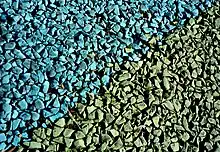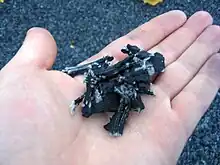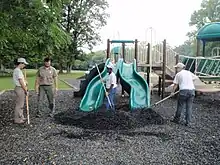Rubber mulch
Rubber mulch is a type of mulch used in gardens and landscaping that is made from recycled rubber, most often crumb rubber sourced from waste tires.

Composition

Rubber mulch generally consists of either waste tire bits or nuggets of synthetic rubber from tires that are shredded or ground up whole, after having their steel bands removed. Almost any tire can be used to make rubber mulch, including passenger vehicle tires and large truck and trailer tires. Bits or nuggets are produced from shredding and steel removal from waste tires. Rubber Mulch (Bits and Nuggets) range in size from 10 mm to 32 mm, or 3/8 inch to 11⁄4 inch.
Advantages
Rubber mulch provides some advantages over plant mulches. For landscaping and gardening purposes, both nuggets and buffings insulate soil from heat, allowing a 2 or 3 degrees F higher soil temperature difference over wood mulches. Rubber mulch is beneficial for soil moisture, as rubber is non-porous and does not absorb water on its way through to the soil. It also reduces fungus growth and plant growth, and becomes a weed barrier, as weed seeds dehydrate in the mulch before reaching the soil.

Another advantage over plant-material mulches is its elasticity, which gives it a springy quality when used in a fairly thick layer. This makes it a choice for playgrounds, where the springiness provides additional safety for children when they fall off of playground equipment. Tests have shown that rubber mulch is superior in breaking falls[1] to traditional bark mulches. The International Play Equipment Manufacturers Association has certified some rubber mulches for ASTM F1292-09.[2]
Disadvantages
Unlike organic mulch, rubber mulch does not enrich soil or increase soil biodiversity through decomposition. Neither nuggets nor buffings provide any humus to compacted soil types. At worst, it leads to soil contamination (see Environmental Impact and Safety Testing) Some recycled varieties may leach chemicals (some toxic) which are harmful to plants[3][4][5] Rubber mulch is a particular hazard if ignited because of the resulting fumes that resemble those produced in tire fires. Rubber mulch is also more likely to ignite and harder to extinguish than other mulches.[6] Compared to organic mulches, rubber mulch can become extremely hot when in direct sunlight. [7] There is concern about the potential for negative effects of rubber mulch nuggets migrating into waterways.
Environmental impact and safety testing
In the US, the Environmental Protection Agency (EPA) has launched a multi-agency Federal Research Action Plan on Recycled Tire Crumb Used on Playing Fields and Playgrounds to study key environmental human health questions concerning the safety of recycled tire crumb.[8] The EPA previously studied air and surface samples at four fields and playgrounds that use recycled tires. The limited study, conducted in August through October 2008, found that the concentrations of materials that made up tire crumb were below levels considered harmful. In addition, the overall study protocol and many of the methods were found to be appropriate and could be implemented in the field.[9] The study, however, did note that due to its limited nature and the large diversity of materials used to make tire crumb, no definitive conclusions could be reached.[9] More recently, the EPA has released a comprehensive spreadsheet with toxicity reference information.[10]
The California Office of Environmental Health Hazard Assessment (OEHHA) used guinea pigs, in an animal study, to test skin sensitization by playground surfaces made of recycled tires and observed no sensitization. This suggested that these surfaces would not cause skin sensitization in children, nor would they be expected to elicit skin reaction in children already sensitized to latex.[11] The OEHHA has conducted additional studies on potential negative human health effects associated with the use of recycled waste tires in playground and synthetic turf products.[12]
Although rubber mulch is generally regarded as safe, recycled tire rubber leachates do contain certain minerals and compounds which may be ecotoxic in high concentrations. Recycled tire mulch can contain trace amounts of various minerals from the tire manufacturing process and other chemicals that may have been picked up during the tire's service life. The greater the surface area of synthetic rubber waste pellets, the greater the potential for breakdown into harmful constituents. For leached tire debris, the (potential) environmental impact of the ingredients zinc and organic toxicants has been demonstrated.[13]
References
- EPA playground surface
- IPEMA Certification Description Archived 2011-07-13 at the Wayback Machine
- Natures Way Resources
- The Myth of Rubberized Landscapes, Linda Chalker-Scott, Puyallup Research and Extension Center, WSU Archived 2008-09-07 at the Wayback Machine
- Rufus L. Chaney Environmental Chemistry Lab USDA-Agricultural Research Service Archived 2008-05-13 at the Wayback Machine
- The Combustibility of Landscape Mulches
- Linda Chalker-Scott, Ph.D., Extension Horticulturist and Associate Professor, Puyallup Research and Extension Center, Washington State University The Myth of Rubberized Landscapes “Recycled rubber mulch is an environmentally friendly, non-toxic choice for landscapes”
- US EPA, ORD (2016-02-12). "Federal Research Action Plan on Recycled Tire Crumb Used on Playing Fields". www.epa.gov. Retrieved 2022-11-22.
- EPA fields and playground study
- US EPA, ORD (2019-07-24). "July 2019 Report: Tire Crumb Rubber Characterization". www.epa.gov. Retrieved 2022-11-22.
- "Evaluation of Health Effects of Recycled Waste Tires in Playground and Track Products (622-2006-0013)". www2.calrecycle.ca.gov. Retrieved 2022-11-22.
- "Synthetic Turf Studies". oehha.ca.gov. Retrieved 2022-11-22.
- Gualtieri, Maurizio; Andrioletti, Manuela; Mantecca, Paride; Vismara, Claudio; Camatini, Marina (2005). "Impact of tire debris on in vitro and in vivo systems". Particle and Fibre Toxicology. 2 (1): 1. doi:10.1186/1743-8977-2-1. PMC 1079942. PMID 15813962.